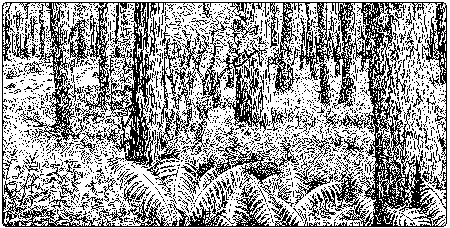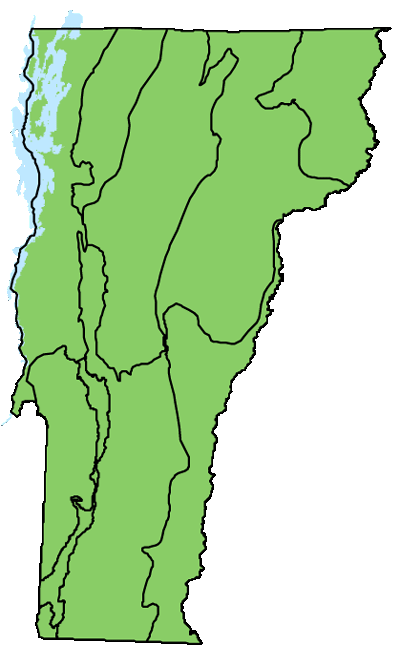Ecology and Physical Setting 
This natural community is characteristic of settings where flooding is infrequent and of short duration. Sugar Maple Floodplain Forests are associated with our higher energy, higher gradient rivers, or less commonly, floodplain terraces above lower gradient rivers and streams. Soils are well-drained to moderately well-drained fine sandy loams. On high gradient rivers, this sandy soil often lies over rounded cobbles that were formerly part of the river channel. Soil mottling is usually absent. There is generally no surface organic horizon or significant profile development in these alluvial soils. These are mostly upland soils, but small hydric soil inclusions may be present in old meander swales. Only some examples of this community type qualify as wetlands; the majority are uplands.
Vegetation

Sugar maple is the dominant tree in the relatively closed canopy, but white ash is abundant at some sites. Basswood usually occurs in relatively low abundance, but it is characteristic of these forests. On well-drained sites, red oak may be common, and in the southern part of the state there may be large sycamores mixed in the canopy. Black cherry is another canopy associate.
These forests typically have more structural diversity than the silver maple floodplain forest types, with sugar maple and white ash common in the subcanopy. Musclewood is also characteristic of the subcanopy and tall shrub layers of these forests, although its overall cover is low. Other than regeneration of tree species, especially sugar maple, there are few low shrubs, although the vines poison ivy and Virginia creeper are often present.
The herbaceous layer is diverse, and includes many species not found in other floodplains. Common species include ostrich fern, white snakeroot, zigzag goldenrod, bottlebrush grass, lady fern, tall meadow rue, and graceful sedge. Rich woods species such as wild ginger, bloodroot, Goldie’s wood fern, Sprengel’s sedge, and hairy-leaved sedge are also associated with these floodplain forests. In spring, wild leeks can be abundant on the forest floor. The Winooski River is named after the Native American word for “onion,” supposedly due to the abundance of wild leeks in the forests along its banks.
The uncommon plant Wiegand’s wild rye and the rare shrub American hazelnut occur in these floodplain forests.
Wildlife Habitat
Many wildlife species favor riparian areas for travel corridors, and Sugar Maple Floodplain Forests contribute to this function. Mink, otter, and wood turtle rely on both the river and the adjacent riparian areas for feeding, movement, and cover. Birds that may nest in these small patches of floodplain forest include yellow warbler, warbling vireo, veery, and Baltimore oriole. Wood duck, hooded merganser, and common merganser make their nests and lay eggs in tree cavities, which are most likely to be available in mature forests with larger trees. Several rare butterflies and moths, all having tight associations with host plant species, may be found in these floodplain forests. The West Virginia white is a butterfly dependent on common toothwort, a rich woods species. Hackberry emperor and tawny emperor are two butterflies that are dependent on hackberry, an occasional species in these forests. And the larvae of the ostrich fern borer moth feeds on the lower stem of its namesake fern, which may be abundant in some Sugar Maple Floodplain Forests.
Related Communities
- Silver Maple-Ostrich Fern Floodplain Forest floods frequently and is distinguished by the dominance of silver maple, the open understory, and the absence of rich woods herbs.
- Rich Northern Hardwood Forests occur on hillsides with active downslope soil movement, and can be very similar to, and share many species with, Sugar Maple Floodplain Forests.
Conservation Status and Management Considerations
Intact examples of this community are rare in Vermont. Due to the rich, productive soils, many examples were cleared for agricultural use long ago. Alterations in flooding regime, scouring, and sediment deposition associated with dams pose a significant threat to floodplains and to other rivershore and aquatic communities. There are only a few, small protected floodplains in the state that include this natural community type.
Distribution/Abundance 
Sugar Maple Floodplain Forests are found in all but the coldest regions of Vermont along moderate to high gradient streams, and on terraces. Similar floodplain forest communities are known to occur throughout New England, New York, and New Jersey, and likely occur in Ontario and Québec.
Characteristic Plants
Trees
Abundant Species
Sugar maple – Acer saccharum
White ash – Fraxinus americana
Occasional to Locally Abundant Species
Basswood – Tilia americana
Musclewood – Carpinus caroliniana
American elm – Ulmus americana
Red oak – Quercus rubra
Sycamore – Platanus occidentalis
Black cherry – Prunus serotina
Cottonwood – Populus deltoides
Hackberry – Celitis occidentalis
Butternut – Juglans cinerea
Red maple – Acer rubrum
Black ash – Fraxinus nigra
Hophornbeam – Ostrya virginiana
Boxelder – Acer negundo
Shrubs and Vines
Occasional to Locally Abundant Species
Chokecherry – Prunus virginiana
Alternate-leaved dogwood – Cornus alternifolia
Poison ivy – Toxicodendron radicans
Virginia creeper – Parthenocissus quinquefolia
Herbs

community.
Abundant Species
Ostrich fern – Matteuccia struthiopteris
Occasional to Locally Abundant Species
White snakeroot – Ageratina altissima
Zigzag goldenrod – Solidago flexicaulis
Sensitive fern – Onoclea sensibilis
Bottlebrush grass – Elymus hystrix
Jumpseed – Persicaria virginiana
Heart-leaved aster – Symphyotrichum cordifolium
Lady fern – Athyrium filix-femina
Graceful sedge – Carex gracillima
Jack-in-the-pulpit – Arisaema triphyllum
Hog peanut – Amphicarpaea bracteata
Tall meadow rue – Thalictrum pubescens
Wild ginger – Asarum canadense
Bloodroot – Sanguinaria canadensis
Sprengel’s sedge – Carex sprengelii
Hairy-leaved sedge – Carex hirtifolia
Wild leeks – Allium tricoccum
Goldie’s wood fern – Dryopteris goldiana
Common toothwort – Cardamine diphylla
Non-native Invasive Plants
Moneywort – Lysimachia nummularia
Ground-ivy – Glechoma hederacea
Japanese knotweed – Fallopia japonica
Dame’s rocket – Hesperis matronalis
Goutweed – Aegopodium podagraria
Common buckthorn – Rhamnus cathartica
Morrow’s honeysuckle – Lonicera morrowii
Japanese barberry – Berberis thunbergii
Rare and Uncommon Plants
American hazelnut – Corylus americana
Hairy honeysuckle – Lonicera hirsuta
Wiegand’s wild rye – Elymus wiegandii
MacGregor’s wild rye – Elymus macgregorii
Associated Animals
River otter – Lontra canadensis
Mink – Neovison vison
Raccoon – Procyon lotor
American beaver – Castor canadensis
Great crested flycatcher – Myiarchus crinitus
Warbling vireo – Vireo gilvus
Yellow-throated vireo – Vireo flavifrons
Veery – Catharus fuscescens
Yellow warbler – Setophaga petechia
American redstart – Setophaga ruticilla
Baltimore oriole – Icterus galbula
Wood duck – Aix sponsa
Hooded merganser – Lophodytes cucullatus
Common merganser – Mergus merganser
Pileated woodpecker – Dryocopus pileatus
Great blue heron – Ardea herodias
Green heron – Butorides virescens
Baltimore oriole – Icterus galbula
Ebony jewelwing – Calopteryx maculata
Slender spreadwing – Lestes rectangularis
Rare and Uncommon Animals
Wood turtle – Glyptemys insculpta
West Virginia white – Pieris virginiensis
Hackberry emperor – Asterocampa celtis
Tawny emperor – Asterocampa clyton
Ostrich fern borer moth – unnamed Papaipema species
Places to Visit
Randolph Village Floodplain, Randolph
White River Wildlife Management Area, Sharon, Vermont Fish and Wildlife Department
Townshend Dam Floodplain, Townshend, U.S. Army Corps of Engineers
